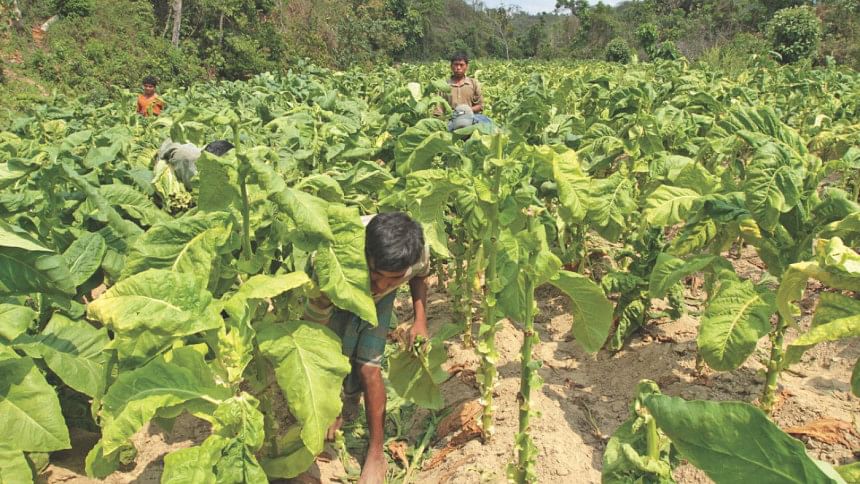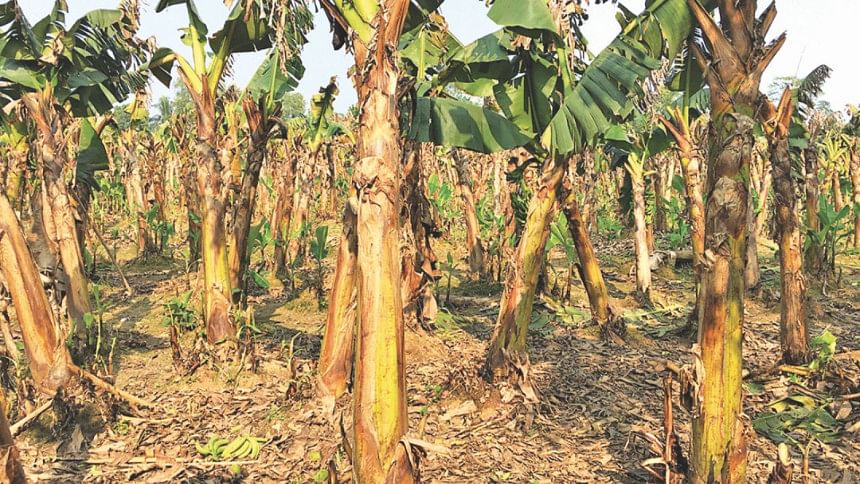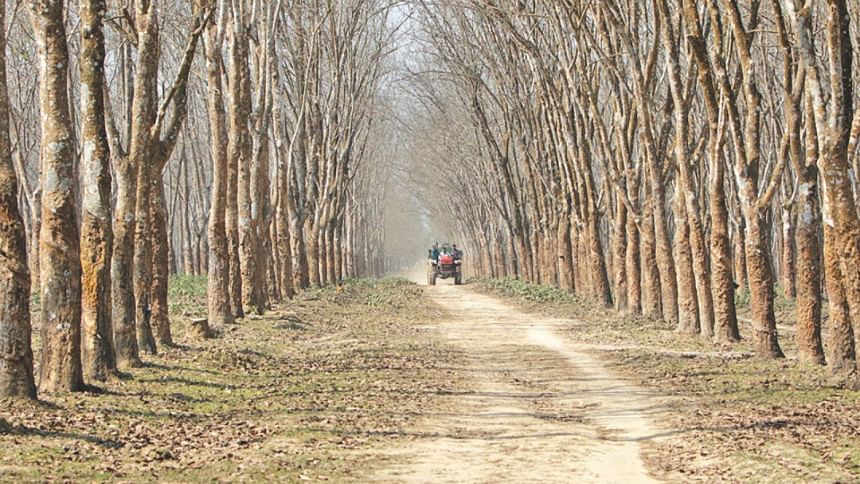Philip Gain | News Link
Rubber plantation in place of sal forest. Photo: Philip Gain
Sicilia Snal, aged 25 in 2006, was shot when she went to collect firewood in the forest near her village. Sicilia is a Garo woman of Uttar Rasulpur, in Madhupur sal forest area. It was early in the morning of August 21, 2006, that Sicilia went to collect firewood with a few other Garo women. On their way back, they put down their loads to take rest for a while. All of a sudden, to their great surprise, the forest guards fired shots from their guns. Sicilia was hit. She fell to the ground, unconscious and bleeding. Terrified all but one woman fled.
Then other villagers came to her rescue. She was immediately taken to Mymensingh Medical Hospital where she had a crude surgery and her gall bladder, plastered with many pellets, was removed. Some pellets remained in her kidney and around 100 pellets in the back of her body and hands—she has to live with these for the rest of her life.
Eleven years have passed since she was shot. The local Garos staged some protests and small humanitarian aid came to her family immediately after the assault. A case was also filed on her behalf. But the forest guards who fired the gun shots were never brought to justice. Nobody seriously moved with the case either.
Sicillia and other Garo women still go to the forests, their ancestral land, to collect firewood. Asked about the state of the case filed on her behalf Sicilia says in great frustration, “I know nothing about the case.” She believes the Forest Department and the Forest Guards are immune from legal action.
Before and after Sicilia was shot, a few killings and abuse of forestland in Madhupur made headlines in national and international newspapers. Notable among them was the killing of Piren Snal that left the Garos in terror. On January 3, 2004, the Garos organised a peaceful rally to evince their disdain against the so-called eco-park within the Madhupur National Park. While the Forest Department was desperate about fencing an area with concrete walls to demarcate the eco-park, the Garos saw it as a threat and an attempt to restrict their free movement in the forest they consider as their ancestral land.
The forest guards, with support from other security agencies, fired shots from their guns to disperse the rally. Hit by bullets, Piren Snal, a 28-year Garo youth from Joynagachha village, died on the spot. Utpol Nokrek, an 18-year youth then, was shot from the back, right into the spine that sent him to a wheel chair for the rest of his life.
The Madhupur sal forest is just one hotspot of abuses inflicted on forest villagers. The Chittagong Hill Tracts (CHT) is a vast forest landscape of Bangladesh that demonstrates serious abuses of all kinds done to the forest and forest people. Let me give the example of a small Chak forest village in Bandarban—and how the Chaks were eventually evicted from it.
It was in December 2008 that I first went to Badurjhiri, in Naikhongchhari upazila in Bandarban, which was, at the time, inhabited by 15 Chak families. Distinct from other ethnic communities in Bangladesh, this tiny Chak community lived for centuries in remote forest villages, satisfied with their traditional jum agriculture. Guided by a group of Chak men, we walked three and a half hours from Baishari Chak paras (hamlets) in Naikhongchhari upazila to reach Badurjhiri.
There had always been fears about invasion by Bangalees attracted to the land’s forest produce and encroachment of rubber and tobacco plantations by them, but Badurjhiri remained vibrant nonetheless, with crops that came from jum, pigs, fowls, and a rich variety of vegetables.
Going back to Badurjhiri in December 2010 was something of a shock. The rubber cultivators had expanded their boundaries towards Badurjhiri. The Chak men and women we walked with explained how the jungle continued to be cleared for rubber cultivation. In 2008, when we were passing through Amrajhiri, the jungle was being cleared in preparation for fresh rubber plantation. The nearby hills in the east, west, and south still had coverage of native forests. Two years later, we found out that the entire area had been cleared.

Commercial tobacco cultivation in Naikhhongchhari that is destructive for the forest. Photos: Philip Gain
Rubber cultivation was fast taking over their village, and the Chaks were afraid of what awaited them. They had witnessed how rubber plantation, among other reasons, had forced the Chaks of the neighbouring Longodujhiri (Khal) Chak Para to abandon their village. A Thoai Ching Chak, a villager, remarked, “If rubber cultivation spreads close to our village, we will surely be evicted.” He perhaps did not imagine that his fear would come true so soon.
They had to desert their village in April 2013.
Before the eviction, every time I would go to Badurjhiri, a group of Chak men and women would accompany me, but when I went back in 2013, they refused to go there. They told me horrific stories of attacks on them. On the night of March 19, 2013 the whole village was attacked by armed assailants in the dead of the night. For hours they stabbed and beat men and women, vandalised houses, slaughtered chickens (and loaded them in sacks), and looted belongings.
After the deadly attack, young girls and the wounded immediately left Badurjhiri. In April, almost all of the Chaks of Badurjhiri deserted the village. The 15 Chak families of Badurjhiri took shelter in four Chak villages in Baishari. They still live there.
Abuse, ill treatment and underlying factors
Abuses and ill treatment of the forest people—in Madhupur, Chittagong Hill Tracts (CHT), Khasi hamlets or other sal forest areas—are mere symptoms of underlying factors that have brought the forest to ruin. Officially, 18 percent of the country (2.6 million hectares) is public forestland—landmass recorded as forestland when the Forest Act of 1927 came into being. But in reality, approximately 6 percent is said to be covered by forests. This includes the mangroves and plantations covering 403,458 hectares since 1873. According to the Forest Department estimate, it now controls only 10.3 percent of the land surface (Forest Department 2001).
The largest category of forests in Bangladesh is reserved forests, which include the Sundarbans in the southwest (601,700ha), and forests in the CHT region in the southeast (322,331ha) and the Madhupur tracts in the north-central region (17,107ha). A much smaller category is the protected forests. Privately owned forests are another category, which range from plantations to those that are wholly owned by private individuals or companies. The last category of forests is unclassed state forests (USF), most of which is in the CHT.
 Hills cleared for rubber plantations. Photos: Philip Gain
Hills cleared for rubber plantations. Photos: Philip Gain
The relationship between people living in and around the forests is intimate—reciprocal and spiritual. The life and culture of the forest communities centre around the forests and the forest ecology. Their sustenance is dependent on the forest and therefore they do what they can to protect it. They are the “children of the forest” in the truest sense. To them civilisation and culture are inexorably connected with land, ecology and nature. It wasn’t too long ago that most of the indigenous peoples of Bangladesh lived in forests. Many factors, including actions taken by the state, have led to the massive destruction of the forest, and dispossessed forest communities of their land.
Reservation of the forests, beginning in the days of British colonial rule, has greatly curbed the rights of different indigenous communities to the land and the forests. In the CHT, about a quarter of the land was declared reserved forest during the British colonial era, severely limiting access of the indigenous communities to the land that had been their commons for centuries. Reservation of forest continues to date.
The local communities consider the expansion of the reserved forests as an immoral act. It dispossesses them of the means of their livelihood, and does immense harm to biodiversity and to knowledge production about medicinal plants of the local indigenous communities. The expansion of reserved forests, mainly for plantations, financed by international financial institutions (IFIs) and donors, has further muddied the waters when it comes to questions about land and ecology in the CHT, Madhupur and elsewhere.
Monoculture plantation has been the single biggest threat to the native forests in the hills as well as in the plains, affecting the life and livelihood of the forest-dependent communities. Plantations in Bangladesh include pulpwood (in the CHT), rubber, agroforestry, woodlot (for the production of fuelwood), teak, pine, etc. It is mainly the Forest Department and Bangladesh Forest Industries Development Corporation (BFIDC) that carry out the plantations on public forestland, mostly in the CHT, Chittagong, Cox’s Bazar, Sylhet and the sal forests. The IFIs—ADB and World Bank—funded most of these recent plantations.
The negative multiplier effects of manmade forest or plantations are quite similar around the globe. This is best illustrated in the words of Patricia Marchak (in her book, Logging the Globe, 1995), a Canadian scholar: “Plantations are monoculture, and the lack of biodiversity is of concern. They typically have sparse canopies and so do not protect the land; they cause air temperatures to rise, and they deplete, rather than increase, the water-table. They are generally exotic to regions. While the initial planting may be free of natural pests and diseases, that situation will not last, and plantation regions may not be in the position to combat scourges yet to arrive.”
When we look at the plantations on our public forestland, Patricia Marchak’s contention begins to make sense. It is possible to plant trees but it is impossible to create a forest. Hundreds of species of trees and bushes and a large number of other vegetable species grow on the forest floor. The knowledge of the forest-dwelling communities, their traditions, culture, history, education are all part of the forest. And now, all this has been seriously affected.
 Mountains after mountains have been cleared in Bandarban like this for preparation of rubber plantations. Photo: Philip Gain
Mountains after mountains have been cleared in Bandarban like this for preparation of rubber plantations. Photo: Philip Gain
The displacement of human communities is another consequence of a plantation economy. In the CHT, pulpwood and other industrial plantations (including rubber and tobacco) have displaced human communities (jumias in particular) who have lived in the forests for centuries. The eviction of the Chaks from Badurjhiri and Longodujhiri in Bandarban is a clear pointer to the effects of plantation on forest villagers.
Ecological damage caused by rubber plantation and the so-called social or community forestry on public forestland is another concern. Although a rubber plantation looks green, it is a desert for other plant species, birds and wildlife. It brings in some cash for the government and private entrepreneurs, and misery and trouble for the local communities.
Vast expanses of banana, pineapple, papaya and spice plantations that we see in Madhupur sal forest can have far-reaching effects on the soil, seeds, wildlife, and human health. The trade in chemical pesticides, fertilisers and hormones related to it is huge.
Plantations provide ample ground to land grabbers to illegally convert the forestland to agricultural land. And it is the rich, the influential and the outsiders who encroach upon forestlands in collusion with government agencies and political forces. Banana plantations, illegally established on a massive scale on the forestland in Madhupur, are an example of how the plantation economy gives outsiders an opportunity to encroach upon public forestland. It is primarily the rich and the politically influential who control banana cultivation and benefit from it.
Aside from the plantations carried out with foreign funds (both loans and grants), state-sponsored and aid-dependent ‘development’ initiatives from the Pakistan era have had devastating consequences for the land and forests in the CHT. During the Pakistan regime, two development interventions of the state, Karnaphuli Paper Mill (KPM) and the Kaptai Hydroelectric Project, were a matter of “national pride”. But the projects caused unprecedented ecological damage from the start and posed the biggest threat to the indigenous peoples of the hills and their economic, aesthetic, and political life.
Is there a fix?
It is in the best interests of the nation and its people that whatever is left of the native forests in Bangladesh is protected from the onslaught brought about by monoculture plantation and human greed. Given all the damage done to the forests since colonial times, a natural fix is difficult to come by. However, if there is any hope of protecting what little is left, all actors, particularly the government agencies and donors, must recognise the underlying factors that have ruined the forest(s), especially the plantation economy and development initiatives taking place on forestland.
The surviving forest patches of Bangladesh are still so rich that the seeds and coppices would easily regenerate a degraded forest. A mature sal tree in any sal forest patch, for example, produces thousands of seeds in a season alone which can be planted for its expansion.

Banana plantations that have ruined much of sal forests to the core. Photo: Philip Gain
The sal forests in Madhupur and elsewhere provide an environment conducive for hundreds of other species of plants and life forms to grow. Professor Salar Khan (late) who guided the National Herbarium for many years requested the Forest Department not to plant exotic species to create monoculture in a place home to hundreds of native species. He tried to convince the department that the consequence of single species plantation is the destruction of genetic resources that the sal forest had sustained. He was ignored. He consistently requested the Forest Department to protect the remaining sal forests and replant wherever possible. ADB’s withdrawal from funding any forestry project in Bangladesh since 2007 is evidence that Professor Salar Khan was right. The World Bank’s funding in the forestry sector is reportedly limited.
In the CHT a hill left untouched for some years becomes green with myriad native species. In an abandoned jum plot in the CHT, countless native species appear and spread throughout the plot only in a few years. But a hill, planted with teak, pulpwood or other industrial monoculture, is likely to be ruined. Plantation is a manmade disaster that needs to be prevented in any forestland that has a chance to regenerate. However, “complex” or mixed plantation can be an option in areas that are truly degraded. Even in that situation there is no need for exotic species; there is plenty of local species.
Wrongs done to the forests and forest-dwelling communities need to be righted if justice is to be done. For that to happen, both forest and forest-dependent communities must be given protection. We should not forget the warning of Chandi Prashad Bhatt who said: “Unless we find a framework in which forests and people can live together, one or the other will be destroyed.”
Philip Gain is a researcher and the director of Society for Environment and Human Development (SEHD). He has been reporting, writing and filming on Madhupur sal forest, the Chittagong Hill Tracts and forest people since 1986.

